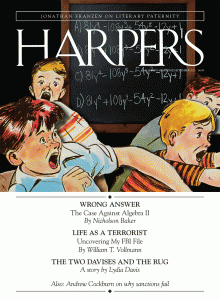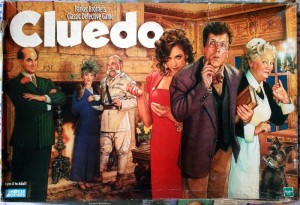THIS SEPTEMBER ISSUE: TWELVE REASONS TO CHOOSE HARPER’S
THE BRIEF HISTORY OF HARPER’S CLUB
Six days ago I received an email with the subject: “HARPER’S MAGAZINE RENEWAL.” The line of argumentation the email included was constructed by the magazine’s “Circulation Director.” I never read it, because I believe everything it said: I didn’t need to be persuaded in regards to the absolute necessity of my continued subscription. [1]
The motive that initially made me subscribe to Harper’s was my desire to intellectually engage on a more personal level with a friend from college, Dan. We both agreed that the depth of our homosocial rapports was not adequately profound, and because we enjoyed discussing with one another we eventually came up with the idea of what we jocularly referred to as “Harper’s Club.” [2] Dan’s academic interests were very different than mine, but we both enjoyed challenging various points of view in our pursuit of forming an informed opinion.
The planning of The Club’s meetings became impossible and our friendship never deepened. Regardless of this failure I could not be happier for the epiphenomenal ramifications of our failed initiative. By encouraging me to think about familiar subjects in different ways, “Harper’s Club” regularly challenged me as a thinker. This held true even when I was the solitary member of the Club, and continues to be valid to this day. Every time a new issue arrives in my mailbox I expect to encounter articles that serve this mission. My expectations are pleasantly surpassed consistently.
THOUGHTS ON ADS (ATTN: MIGHT BE FEELINGS!)
In the occasion this may thus far read too much like an ad, it may certainly appear more persuasive and eloquent than the ads one finds in the pages of the respected publication itself. I have a problem with most the ads I see in Harper’s. Naturally, it is not the ads themselves that agitate me, nor the absence of luxury brands fighting for a literary journal’s readership. [3]
My frustration with these ads is linked to believing that the magazine is severely underappreciated from a market standpoint. How can such an impressive product covering issues of general interest in compelling ways, featuring articles that matter from contributors that also matter, not hold more commercial influence? Much of the advertising featured in the pages of Harper’s is of a questionable aesthetic. Perhaps this could be indicative of a sense of heightened skepticism the magazine’s primary audience experiences in finding meaning in the sort of materialism mainstream advertising celebrates. If advertisers and the firms they represent were aware of this hypothetical skepticism, it would makes sense to approach consumers through other channels, ones that cater to less skeptical audiences. [4]
I enthusiastically consume every issue in its entirety. My excitement is directly linked to the lack–or the very limited appearance–of tiring or theoretically exhaustive pieces. This September issue serves as a solid example of the craftily put-together theme-driven element that has remained intact in the post-Lapham era.
TWELVE REASONS TO GET HARPER’S THIS SEPTEMBER
1. LETTERS: in which the editors have chosen to provide ample space to the readers who questioned Edmundson’s persuasive and polemical essay on the state of contemporary poetry. Edmundson calls for modern poets to try to speak to many and be less arcane.
A reader phrases his opposing views on the importance of poets attempt to reach a larger size of the audience: Edmundson is extreme in addressing creators’ duty to cater to a collective. There is much to be celebrated in the beauty of language that cannot appeal to a mass, argues the reader.
Another reader responds to the writer’s disenchantment pertinent to the lack of a widely-spread poetry in present times. The reader brings attention to the hip-hop and rap genres, in which musicians who turn to seemingly-simple lyrics to masterfully convey the ephemera that define our reality. This response voices the way the majority of progressively-minded consumers of hip-hop feel.
2. EASY CHAIR, If Memory Swerves: in which Thomas Frank briefly summarizes the circumstances that led to The Great Recession of 2009 and defined its severity, such as the market failure of major financial institutions. In face of such dire urgency in addressing the vulnerability of financial institutions ultimately convinced agents of the state that “too-big-to-fail” entities were deserving of protecting.
Frank concludes that the power of the strong institutions was actually (further) pragmatized via the government’s financial support and aid packages. Manipulating the mechanisms that the financial industry employs, the “great capitalists looked like criminals.”
3. THE ANTI-ECONOMIST, Saving Your Children from a Harvard Education: in which Madrick–whose own studies found him under the Harvard educational umbrella–asserts today’s Harvard trained economists primarily focus on an education that centers on the maximization of fiscal profits. The writer states that the department of Economics at the prestigious institution audaciously chooses to emphasize wealth management over development economics.
Madrick further criticizes the lack of moral integrity in academia, even–facetiously–hinting at the necessity of introducing an honor code for Harvard faculty. It is the same faculty responsible for allowing students to work on projects lacking in their scholarly refinement, such as that of a student whose dissertation claimed Hispanic migrants demonstrate lower IQs than “native whites.”
4. HARPER S INDEX: Numerical values stick out more prominently when placed within quantitative values that facilitate comparisons. Find what shocks you: here.
5. READINGS, [Footnote] A DIFFERENT KIND OF FATHER: in which Jonathan Franzen. Fine, on a serious note it follows Franzen’s quest for a literary father as he realized he couldn’t take Pynchon. The quintessential Franzenian element of presenting his guilt for his (intellectual? self-proclaimed?) superiority over his partner comes up as he recalls his successful endeavor to obtain a Fulbright to Germany, while his lover gets rejected. (In a latter point, the writer humblebrags about “tricking the system” in bullshitting the scholarly goals he presented to the Fulbright Foundation.)
Briefly returning to the paternal theme of the essay, he chooses to rise beyond his true father who, according to the Franzen, was not particularly invested in literature. Trying to stylistically evoke the Pynchonian prowess he admired in Gravity’s Rainbow during his youth, the writer proved his utmost dedication to literature. He inserted such segments in his personal correspondence to his lover, much at her distaste. Perhaps what Franzen doesn’t realize is that if he were Pynchon he would probably not be seeking affirmation from his romantic interest.
6. [Mystery] THE MARRIAGE PLOT: in which a police report unfolds like an IRL version of the boardgame Clue(do) between a married couple.
Scenario I. Was the husband intending to fake his wife’s accidental death to receive hefty health-insurance fees? The fees could cover his pending debts from dental school, which he was also not successfully completing.
OR
Scenario II. Was the failing student triumphantly surrendering to his failure, attempting suicide to evade such embarrassment? Had he just tried to exit discreetly, by first ensuring that his wife’s awakening in the midst of his attempt wouldn’t lead to yet another failure? Was that why the husband used chemicals to make his wife sleep?
7. [Correspondence] LAST REQUEST: in which an email exchange between an Iraqi man, “Omar,” and the US State Department brings attention to the perils resulting from bureaucratically-induced detachment.
Omar is sporadically and repeatedly sending pleas to emigrate Iraq, as he was receiving continuous threats for his life. The final email the US entity receives from Iraq is sent by Omar’s brother, informing the state of his death. His tone is accusatory, as his brother’s death was irrevocably linked to the lengthy inaction of the American government. The callous bureaucracy that led to Omar’s death is last crystallized with this monstrous email:
“Thank you for your email. Please provide us with your brother’s death certificate. Kind regards.”
8. [Research] THE INVENTORY ROOM: in which a detail-abundant portrait of the inventory room is presented. It is where the genealogies of citizens are tracked and archived. Chronotopically, the key difference of the monotonous bureaucracy this piece provides is derived from its writer’s academic specialty as a scholar of eighteenth century France. Many idealize the past as the memory of limited bureaucracy, but this piece reminds readers that bureaucratic processes do have a history.
9. [Fiction] TWO WOMEN: in which an intricate love triangle destroys a marriage. As the man who cheated was also the one in the marriage who left first, the courage of the heroine to still care about him becomes admirable. Osnat, the abandoned first wife, intentionally leaves a note in his pants to inform her replacement of her husband’s idiosyncrasies. Osnat’s brief note functions as a catalyst for a peculiar correspondence between the two women, through which we realize nobody is happy in this saga, but there is a high possibility the betrayed Osnat is entitled to claiming more sadness than she chooses to silence.
10. ESSAY, WRONG ANSWER. The Case Against Algebra II: in which Nicholson Baker argues that having Algebra II as an educational requirement is regressive, or rather wrong. Such a requirement contradicts the spirit of “celebrating” individuality which is often perceived as a central element of a thorough education: not everyone’s brain processes things in a similar manner.
In his attempt to estimate the emotional negativity students experience when taking the class, Baker employs an erroneous technique: he cites statements made by teenagers on online forums sans recognizing the dramatic vigor of such comments is very rarely authentic. Most of them are probably not contemplating suicide because of a course.Regardless of this error, the essay succeeds in making a strong case, successful in evoking strong sentiments from readers: whether of agreement or disagreement.
The writer thinks a portion of the student population can not think in the manner Algebra requires them to. Persuading the readers of the empirical validity of Baker’s certainty in his belief would mark the end of required Algebra.

11. REPORT, LIFE AS A TERRORIST: in which William Vollman uses the Bureau’s information on him to illustrate that we live in public, and how alarming the rising invasiveness of personal freedom we are adhering to–due to the inexistence of alternatives–is. “Where does legitimate investigation become harrassment?,” he rhetorically fake-asks as he contemplates the erroneous assumptions he encountered in examining his FBI File.
12. ANNOTATION, Helter Seltzer: in which the multifaceted dialectic over the corporate ethics of an Israeli-manufactured kitchen product that enables its owners to carbonate at their own domestic convenience. Specifically, the claims of environmental sustainability proudly advertised intended to appeal to the emotional attachment of prospective customers to The Earth. Apparently, critics/ Earth-believers insist that such advertising celebrates claims and not facts: the factory adds to the pollution Earth-believers strive to mitigate. Clearly, the country of production adds to the controversy, as a –surprisingly–considerable chunk of the international market experiences ambivalence in purchasing goods coming from a country that continues the legacy of political turmoil Saddam Hussein left behind.
*
ANNOTATION
The ANNOTATION feature is often a rigorous read, despite its confinement in length to two pages. Juxtaposing several takes on a theme, it often provides the numerous interests of multiple stakeholders. I think this feature succeeds in proving the moral ambiguity of claiming an absolute truth. The magazine itself does the same by encouraging its readers’ open-mindedness.
I wish that the aforelisticled brief intellectually-self-masturbatory reasons–which by the way are chronicling solely the first-half of this noteworthy issue–have placed Harper’s higher than Vogue on your #musthave September mag wishlist. If you must have the nice ads, you will have to purchase both.
NOTES
[1] In case you are curious this is what the email looked like:
[2] HARPER’S CLUB: A tragically short-lived and always unregistered 501(c) organization that primarily focused on deepening the friendship between two young men who shared an alma mater. Initially meeting in apartments, moving on to bars and eventually ceasing meetings as the non-narrating male abandoned the borough in which the organization was first established.
A very attractive and definitely much smarter female entity the founding parties had both been romantically interested in expressed interest in attending the monthly meetings, but was systematically rejected. Outside the club, both founders would never reject her nor her wet eyes that put to shame their andric intellect combined.
[3] Three randomly selected ads from September’s issue are for the following products:
i. The new Rabbit Wine-Chilling Carafe
ii. The Jitterbug Plus Cell Phone, which does not seem very smart
iii. Athena Pherom<3nes: unscented fragrance additives (which increase affection!)
[4] The plethora of existing exegeses written on the slow death of print signify that rewriting them is fruitless. Trying to comprehend how the internet instigates drastic changes in media industries would be more beneficial. Evan Kindley’s piece “Chiquita Banana Jingle” investigates the changes occurring in the music industry as technology advances and the internet makes everything accessible sans adequately rewarding the artists.
Kindley thoroughly questions the multilayered motivations and incentives of musicians who try to liquidate on their work, in what he succinctly describes as “the post-Internet economic landscape.” As daily habits change to reflect advances in technology, so do our consumption patterns of media. Inevitably, the demand-supply functions of how musicians become commercially-successful follow a dynamic curve that attempts to respond to the changing habits of audiences that no longer buy music the same way they did a decade ago.
The osmotic nature of advertising as it pertains to the music industry, shows that the symbiosis of commerce and art which advertising professionals thought possible might truly exist. Musicians considering the economic rewards, as well as the opportunity to reach wider audiences, might decide that they do want their work used in ads. Such considerable advantages provide insight to the way the current economic model mechanism works in the music realm. The critics who dismiss artists for choosing to partake in an activity that benefits them as sellouts are not only forgetting that it was a choice they made, but also appear anachronistic in their understanding of musicians’ economic reality.
Examining the creative integrity of certain artists with more empathetic intentions, it is hard to scrutinize them for their participation in ads. In fact, many ads today instantaneously seem like a reflection of our culture, as for instance the first TV spot for cereal featuring an interracial household. Certainly, the ads a publication includes are not its defining paragons. However, I always remember to forget the last few pages of New York in the same way I pay meticulous attention to ads in The Village Voice for some cult lols. Perhaps it is a little vain, but I want more cool ads in the journals I appreciate. That would make me feel that smart things might have mainstream appeal, which would be a nice development.
Tags: Harper's Magazine, jonathan franzen, Nicholson Baker, Vogue, William Vollman






WASN’T THAT FRANZEN THING “FUCKED”? ZZZIPP COULD HEAR THE NECK VESSELS OF A MILLION HTMLG COMMENTERS SNAPPING WHENEVER FRANZEN QUOTED AT LENGTH FROM HIS JUVENILE CORRESPONDENCE. “IF NO ONE ELSE IS GOING TO, I WILL,” ZZZIPP IMAGINED FRANZEN SAYING TO HIMSELF EVERY TIME HE BEGAN ADJUSTING THE PAGE MARGINS IN PREPARATION TO TRANSCRIBE ANOTHER SHEET.
ANYONE ELSE FIND IT WEIRD THAT THE EXCERPT IN HARPER’S WAS ITSELF AN EXTRA-LONG FOOTNOTE FROM AN EDITION OF KRAUS, IN WHICH HE MENTIONED THAT HE WAS WORKING ON A NOVEL (IN 1981? 82?) WHOSE MAIN CHARACTER’S NAME WAS “WALLACE WALLACE WALLACE”? HE’S JUST MESSING WITH US, RIGHT?
SIX: THE NUMBER OF TIMES I WROTE “VOM” NEXT TO THE TEXT.
fun fact: one of them was next to the 3x Wallace
i thought that article was written by jonathan lethem until i was done & then i wished i hadn’t wasted being stoned on a childhood letter from franzen to himself
harper’s is generally great though, because they’re rich people who take rich people to task, whereas the new yorker is just a monocle on an asshole
oh wow. i m so happy your favorite feature is the findings, bc it s def not on my top five. [thus proves my point]
oh my!
that blue sea star finding is heart-wrenching! (and quite poetic)
i had a professor once, he was the one that taught me the phrase “hoist[ed] on his own petard”, who gave me all his old copies of Harper’s
i taught him the difference between “pablum” and “pabulum”
an online article about not continuing to support a printed magazine. That works.
?? hm.